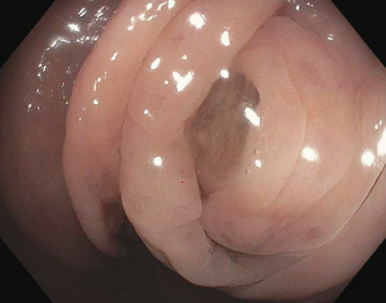Tuesday Poster Session
Category: Colon
P4693 - The “Volcano Sign” on Screening Colonoscopy: A Case Report of Appendiceal Mucocele as a Finding of Underlying Appendiceal Carcinoma
Tuesday, October 28, 2025
10:30 AM - 4:00 PM PDT
Location: Exhibit Hall

Nicholas Colucciello, MD
Atrium Health
Charlotte, NC
Presenting Author(s)
Nicholas Colucciello, MD, Maithili V. Chitnavis, MD, FACG
Atrium Health, Charlotte, NC
Introduction: Appendiceal neoplasms are rare tumors but are increasing in incidence over the last 20 years. Early detection methods are crucial for reducing the morbidity and mortality of this condition, but unlike colon cancer, no screening modalities exist. This case describes a colonoscopy finding of a mucocele at the appendiceal orifice, a finding that may be helpful in detecting insidious cases of appendiceal adenocarcinoma and other dysplastic lesions within the appendix.
Case Description/
Methods: A 47-year-old African American male with a past medical history of hyperlipidemia presented for routine screening colonoscopy. Findings of colonoscopy revealed four 2-4-mm polyps in the ascending and transverse colon, which were notable for normal colonic mucosa. During evaluation of the cecum, mucus was noted to be emanating from the appendiceal orifice, consistent with a mucocele. This finding was concerning for a mucus-producing lesion within the appendix, so a computed tomography (CT) scan of the abdomen and pelvis was ordered and the patient was referred to general surgery. CT revealed a dilated appendix filled with low-density fluid or mucin in the lumen, with wall thickening in the tip. No lymphadenopathy or evidence of metastatic disease was noted. The patient underwent laparoscopic appendectomy with resection of the cecal cap following surgical consultation. Pathology of the appendix revealed poorly-differentiated adenocarcinoma arising in the distal half of the appendix, with mucinous and signet ring features. Given these findings, surgery recommended laparoscopic ascending colectomy with ileocolonic anastomosis. which was necessary for nodal harvest. Pathology of the colon and multiple surrounding lymph nodes (22) did not reveal metastasis. The post-operative course was uncomplicated and he continues to follow closely with medical oncology. Adjuvant chemotherapy was discussed but not pursued in favor of close surveillance with labs and imaging.
Discussion: This report highlights the importance of recognition of the “volcano sign” or appendiceal mucocele. In our case, a patient with an otherwise normal colonoscopy had an appendiceal mucocele, with underlying appendiceal adenocarcinoma with signet ring features. Fortunately, this was identified early and appendectomy was performed before his cancer metastasized. Given the difficulty in early identification of appendiceal carcinoma, the finding of a mucocele in the appendiceal orifice on colonoscopy should not be ignored and warrants further work-up.

Figure: Colonoscopy image of mucocele in the appendiceal orifice
Disclosures:
Nicholas Colucciello indicated no relevant financial relationships.
Maithili Chitnavis: AbbVie – Advisory Committee/Board Member, Speakers Bureau. Eli Lilly – Speakers Bureau.
Nicholas Colucciello, MD, Maithili V. Chitnavis, MD, FACG. P4693 - The “Volcano Sign” on Screening Colonoscopy: A Case Report of Appendiceal Mucocele as a Finding of Underlying Appendiceal Carcinoma, ACG 2025 Annual Scientific Meeting Abstracts. Phoenix, AZ: American College of Gastroenterology.
Atrium Health, Charlotte, NC
Introduction: Appendiceal neoplasms are rare tumors but are increasing in incidence over the last 20 years. Early detection methods are crucial for reducing the morbidity and mortality of this condition, but unlike colon cancer, no screening modalities exist. This case describes a colonoscopy finding of a mucocele at the appendiceal orifice, a finding that may be helpful in detecting insidious cases of appendiceal adenocarcinoma and other dysplastic lesions within the appendix.
Case Description/
Methods: A 47-year-old African American male with a past medical history of hyperlipidemia presented for routine screening colonoscopy. Findings of colonoscopy revealed four 2-4-mm polyps in the ascending and transverse colon, which were notable for normal colonic mucosa. During evaluation of the cecum, mucus was noted to be emanating from the appendiceal orifice, consistent with a mucocele. This finding was concerning for a mucus-producing lesion within the appendix, so a computed tomography (CT) scan of the abdomen and pelvis was ordered and the patient was referred to general surgery. CT revealed a dilated appendix filled with low-density fluid or mucin in the lumen, with wall thickening in the tip. No lymphadenopathy or evidence of metastatic disease was noted. The patient underwent laparoscopic appendectomy with resection of the cecal cap following surgical consultation. Pathology of the appendix revealed poorly-differentiated adenocarcinoma arising in the distal half of the appendix, with mucinous and signet ring features. Given these findings, surgery recommended laparoscopic ascending colectomy with ileocolonic anastomosis. which was necessary for nodal harvest. Pathology of the colon and multiple surrounding lymph nodes (22) did not reveal metastasis. The post-operative course was uncomplicated and he continues to follow closely with medical oncology. Adjuvant chemotherapy was discussed but not pursued in favor of close surveillance with labs and imaging.
Discussion: This report highlights the importance of recognition of the “volcano sign” or appendiceal mucocele. In our case, a patient with an otherwise normal colonoscopy had an appendiceal mucocele, with underlying appendiceal adenocarcinoma with signet ring features. Fortunately, this was identified early and appendectomy was performed before his cancer metastasized. Given the difficulty in early identification of appendiceal carcinoma, the finding of a mucocele in the appendiceal orifice on colonoscopy should not be ignored and warrants further work-up.

Figure: Colonoscopy image of mucocele in the appendiceal orifice
Disclosures:
Nicholas Colucciello indicated no relevant financial relationships.
Maithili Chitnavis: AbbVie – Advisory Committee/Board Member, Speakers Bureau. Eli Lilly – Speakers Bureau.
Nicholas Colucciello, MD, Maithili V. Chitnavis, MD, FACG. P4693 - The “Volcano Sign” on Screening Colonoscopy: A Case Report of Appendiceal Mucocele as a Finding of Underlying Appendiceal Carcinoma, ACG 2025 Annual Scientific Meeting Abstracts. Phoenix, AZ: American College of Gastroenterology.
